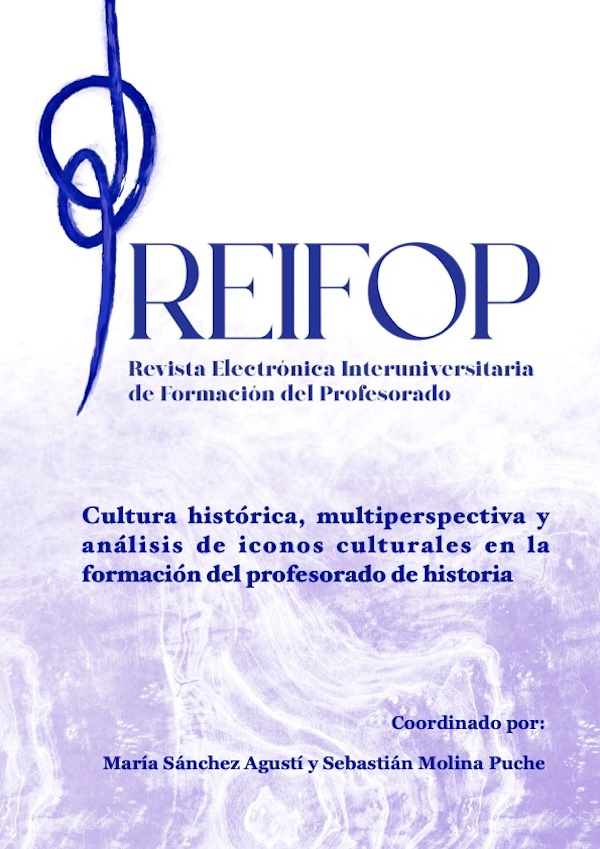Historical figures in primary education: who and what for? In-service teachers’ perspectives
Supporting Agencies
- PID2020-114434RB-I00 - ENSEÑANZA Y APRENDIZAJE DE LA HISTORIA EN EDUCACIÓN PRIMARIA: MULTIPERSPECTIVA Y ANÁLISIS DE ICONOS CULTURALES PARA LA CONSTRUCCIÓN DE UNA CIUDADANÍA CRÍTICA AGENCIA ESTATAL DE INVESTIGACIÓN
Abstract
Teachers' historical knowledge emerges from diverse historiographic, cultural and intrinsically educational influences on what history should be taught and how it should be taught. Therefore, this research aims to determine which historical figures emerge from the imaginary of Primary Education teachers, due to their historical relevance, their educational values and their connection with the present. The sample consisted of 105 teachers from various regions in Spain, who were questioned using a mixed-question instrument, which included both closed and open questions. The results show the pre-eminence of historical figures closely connected with national or regional identities, and with outstanding values of the present, which are given great historical significance and, in general, a high educational value. However, teachers tend to grant this educational value to the characters as a direct exemplification, positive or negative, of current democratic values, which they rarely problematize in their historical context.
Downloads
-
Abstract822
-
pdf (Español (España))482
References
Aguirre M. A. y Ruiz, M. C. (2018). Entre el desconocimiento juvenil y las nuevas demandas de ejemplaridad. Las representaciones sobre los héroes en la Argentina actual. En M. A. Coudannes y M.C. Ruiz (edit.). Los jóvenes frente a la Historia. Aprendizaje y enseñanza en escuelas secundarias (pp. 65-83). Universidad Nacional de La Plata.
Arias, L., y Egea, A. (2019). Who changes the course of history? Historical agency in the narratives of Spanish pre-service primary teachers’. History Education Research Journal, 16(2), 322–39. https://doi.org/10.18546/HERJ.16.2.11
Barton, K. C., y Mccully, A. W. (2005). History, identity, and the school curriculum in Northern Ireland: an empirical study of secondary students’ ideas and perspectives. Journal of Curriculum Studies, 37(1), 85–116. https://doi.org/10.1080/0022027032000266070
Cohen, L., Manion, L., y Morrison, K. (2018). Research Methods in Education (8ª ed.). Routledge.
Counsell, C. (2004). Looking Through a Josephine-Butler-Shaped Window: Focusing Pupils’ Thinking on Historical Significance. Teaching History, 114, 30–33.
Creswell, J. W., y Plano Clark, V. L. (2018). Designing and Conducting Mixed Methods Research (3ª ed.). SAGE Publications.
Gibson, L., Duquette, C., y Leighton, J. P. (2022). What Events in Canadian History Are Most Significant? A Survey of History Teachers. Canadian Historical Review, 103(3), 408–442. https://doi.org/10.3138/chr.2021-0010
Ibagón, N. J., y Miralles, P. (2022). Relevancia histórica desde las perspectivas de estudiantes colombianos. Permanencia y transformación de los modelos de evocación histórica. Memorias, 44, 37–65. https://doi.org/10.14482/memor.44.986.1
Kim, G. (2018). Holding the severed finger: Korean students’ understanding of historical significance. Journal of Curriculum Studies, 50(4), 508–534. https://doi.org/10.1080/00220272.2018.1461934
López, C. (2015). Repensando las narrativas nacionales: Un análisis del origen, transmisión e influencia en el aprendizaje histórico. Panta Rei. Revista Digital de Ciencia y Didáctica de la Historia, 9, 77-92. http://dx.doi.org/10.6018/pantarei/2015/6
López-Facal, R. (2008). Identificación nacional y enseñanza de la historia: 1970-2008. Historia de la educación, 27, 171-193.
Martínez-Rodríguez, R., Muñoz-Labraña, C. y Sánchez-Agustí, M. (2019). Conocimientos y creencias del profesorado y su vínculo con las finalidades de la enseñanza de la historia reciente. La transición a la democracia en España como caso controvertido. Revista de Educación, 383, 11-35. https://doi.org/10.4438/1988-592X-RE-2019-383-399
Miguel-Revilla, D., Carril-Merino, T., y Sánchez-Agustí, M. (2021). An examination of epistemic beliefs about history in initial teacher training: a comparative analysis between primary and secondary education prospective teachers. The Journal of Experimental Education, 89(1), 1–20. https://doi.org/10.1080/00220973.2020.1718059
Pagès, J. (2019). Enseñar historia, educar la temporalidad, formar para el futuro. El Futuro del Pasado, 10, 19-56. http://dx.doi.org/10.14516/fdp.2019.010.001.001
Pagès, J. (2016). Entrevista con el Dr. Joan Pagés Blanch. La Didáctica de las Ciencias Sociales y la formación del profesorado. Perspectivas, 13, 1-12. https://doi.org/10.15359/rp.13.1
Rüsen, J (2007). How to make sense of the past – salient issues of Metahistory. The Journal for Transdisciplinary Research in Southern Africa, 3(1), 169-221. https://doi.org/10.4102/td.v3i1.316
Sainz, J. y López-Facal, R. (2016). Competencias y narrativas históricas: el pensamiento histórico de estudiantes y futuros profesores españoles de educación secundaria. Revista de Estudios Sociales, 52, 87-101. https://doi.org/10.7440/res52.2015.06
Seixas, P. y Morton, T. (2013). The Big Six Historical Thinking Concepts. Nelson Education.
Wellington, J. (2015). Educational Research: Contemporary Issues and Practical Approaches (2ª edición). Bloomsbury.
Wineburg, S., y Monte-Sano, C. (2008). “Famous Americans”: The Changing Pantheon of American Heroes. Journal of American History, 94(4), 1186–1202. https://doi.org/10.2307/25095326
Yeager, E. A., Foster, S. J., y Greer, J. (2002). How Eighth Graders in England and the United States View Historical Significance. The Elementary School Journal, 103(2), 199–219. https://doi.org/10.1086/499723
Los artículos que se publican en esta revista están sujetos a los siguientes términos:
1. El Departamento de Métodos de Investigación y Diagnóstico en Educación de la Universidad de Murcia (España), junto con el Servicio de Publicaciones de la Universitdad de Murcia (Editum) son los editores de la revista REIFOP y conserva los derechos patrimoniales (copyright) de los artículos publicados, permitiendo la reutilización de las mismos bajo la licencia de uso indicada en el punto 2.
2. Las obras se publican en la edición electrónica de la revista bajo una licencia Creative Commons Reconocimiento-NoComercial-SinObraDerivada 3.0 España (texto legal). Se pueden copiar, usar, difundir, transmitir y exponer públicamente, siempre que: i) se cite la autoría y la fuente original de su publicación (revista, editores y URL de la obra); ii) no se usen para fines comerciales; iii) se mencione la existencia y especificaciones de esta licencia de uso.
3. Condiciones de auto-archivo. Se permite y se anima a los autores a difundir electrónicamente las versiones pre-print (versión antes de ser evaluada) y/o post-print (versión evaluada y aceptada para su publicación) de sus obras antes de su publicación, ya que favorece su circulación y difusión más temprana y con ello un posible aumento en su citación y alcance entre la comunidad académica. Color RoMEO: verde.















